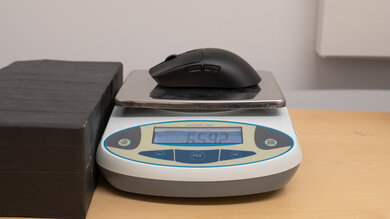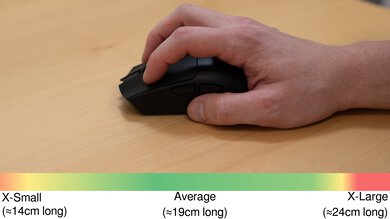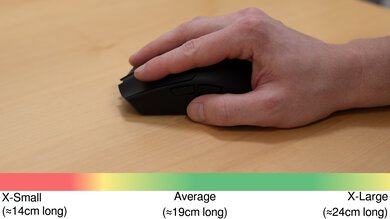The Razer Viper V3 HyperSpeed is a wireless gaming mouse that continues Razer's popular Viper lineup. While it shares a similar symmetrical shape with the other mice in the lineup, it's slightly wider, with a more pronounced hump in the middle of the palm rest. It also has a more subdued aesthetic with fewer aggressive angles and accents than previous Viper mice. A single AA battery powers it, and you can connect to this mouse wirelessly using the 2.4 GHz HyperSpeed USB receiver. It's also compatible with Razer's HyperPolling Wireless Dongle, which supports up to an 8000Hz polling rate.
Our Verdict
The Razer Viper V3 HyperSpeed is a decent mouse for work use despite not being designed for it. It has excellent build quality and a comfortable symmetrical shape, and its buttons are easily reprogrammable. However, its scroll wheel lacks a free scrolling mode and L/R tilt inputs, and you can only pair the mouse to one device at a time.
- Excellent build quality.
- Scroll wheel lacks free-scrolling and L/R tilt controls.
- No Bluetooth connectivity.
The Razer Viper V3 HyperSpeed is an outstanding mouse for FPS gaming. It has remarkably good sensor performance overall, with low click and sensor latency and high accuracy for a very responsive and snappy gaming experience. It feels very well built and has a comfortable symmetrical shape with mouse feet that glide smoothly across mousepads and desks. It's slightly heavier than other mice in the lineup due to the AA battery.
- Superb overall sensor performance.
- Remarkably low click latency.
- Slightly heavier than some alternatives.
The Razer Viper V3 HyperSpeed is a great mouse for MMO and MOBA gaming. It doesn't have as many reprogrammable buttons as dedicated MMO mice, but you can still reprogram almost all of them using the companion software. It has excellent build quality, a comfortable symmetrical shape, and excellent sensor performance, delivering a responsive-feeling gaming experience.
- Superb overall sensor performance.
- Remarkably low click latency.
- Excellent build quality.
- Has fewer additional buttons than dedicated MMO mice.
The Razer Viper V3 HyperSpeed has superb raw performance overall. It has remarkably low click and sensor latency and reacts very accurately and consistently to your inputs.
- Superb overall sensor performance.
- Remarkably low click latency.
Changelog
- Updated Aug 19, 2025: We've converted this review to Test Bench 1.5.1. This update removes less relevant or redundant elements, including several videos. We've also adjusted our Sensor Latency testing, resulting in minor score changes. See our full 1.5.1 changelog for details.
- Updated Aug 09, 2024: We've added a link to the newly-reviewed Logitech G309 LIGHTSPEED in the Hand Size Recommendation of the review.
- Updated May 22, 2024: We've remeasured the dimensions of this mouse and made a minor correction to the Length result in the Shape section. This change has also corrected the Box Volume result in the Portability section.
- Updated Jan 05, 2024: We've updated the CPI graph displayed in the Sensor Latency section of this review. Our results remain the same, but these graphs have two new columns with results from the Delay At Half Movement and Delay To End Of Movement tests.
Check Price
Differences Between Sizes And Variants
The Razer Viper V3 HyperSpeed is only available in black. You can see the label for the unit we bought and tested here.
Popular Mouse Comparisons
The Razer Viper V3 HyperSpeed continues Razer's lineup of Viper gaming mice. It has a similar overall shape and features to other Viper models but with a more subdued aesthetic and a new matte plastic finish. It occupies a mid-range price bracket compared to the more expensive Razer Viper V2 Pro and Logitech G PRO X SUPERLIGHT 2, with the key difference being that it uses an AA battery for power instead of having an internal rechargeable battery. It's also significantly heavier than current flagship wireless gaming mice and uses Razer's older Gen 2 mechanical switches instead of optical ones. That said, it offers similar overall performance to Razer's flagship models at a lower price point.
For more recommendations, see our picks for the best FPS mice, the best gaming mice, and the best wireless gaming mice. Or, if you're interested in other Razer options, see our article on the best Razer mice.
The Razer Viper V3 HyperSpeed and the Razer DeathAdder V3 Pro are both high-end wireless gaming mice. The DeathAdder has an ergonomic right-handed shape and uses an internal rechargeable battery. It's also significantly lighter than the Viper. On the other hand, the Viper uses an AA battery for power and has slightly better build quality than the DeathAdder.
The Razer Viper V3 HyperSpeed and the Razer DeathAdder V3 HyperSpeed are wireless gaming mice. The Viper has a symmetrical shape and uses a replaceable AA battery for power, while the DeathAdder has a right-handed shape and an internal rechargeable battery. The DeathAdder is much lighter and offers significantly better raw gaming performance. Both mice are also compatible with but don't include Razer's Hyperpolling Dongle.
The Logitech G PRO X SUPERLIGHT 2 and the Razer Viper V3 HyperSpeed are high-performance wireless gaming mice with symmetrical shapes. The two perform similarly, but the Logitech is significantly lighter. The Logitech has an internal rechargeable battery and a higher native polling rate of 8000Hz. On the other hand, the Razer mouse supports a polling rate of up to 8000Hz using Razer's HyperPolling Wireless Dongle, but it's sold separately. The Razer also uses an AA battery for power and has slightly better build quality with less flex and play in the buttons than the Logitech.
The Razer Viper V3 HyperSpeed and the Razer Viper V2 Pro are high-performance wireless gaming mice in the same lineup. While the two perform very similarly, the V2 Pro is much lighter, thanks partly to its built-in rechargeable battery. It also uses newer optical switches instead of the mechanical ones found on the V3 HyperSpeed. While the two have a similar overall shape, the Viper V3 HyperSpeed has subtle changes and a new, more minimal aesthetic.
Test Results

The Razer Viper V3 HyperSpeed has a similar overall shape to other mice in Razer's Viper lineup but with a more minimal aesthetic and fewer aggressive angles. It's made of matte black plastic with a soft coating and has a subtle glossy black Razer logo on the palm rest. There isn't any RGB, but it has a small battery status LED in front of the scroll wheel.
This mouse is somewhat lightweight. We obtained the Default Weight result with an AA Amazon Basics rechargeable battery weighing 27.5g. We achieved the Lowest Weight result using an aluminum foil ball adapter to allow the use of an AAA battery. We used an AAA Energizer Lithium battery that weighs 7.6g. If you're interested in a mouse that weighs less, check out the Pulsar X2V2.
The Razer Viper V3 HyperSpeed has a comfortable symmetrical shape similar to other models in the Razer Viper lineup with some subtle changes. Notably, the hump in the middle of the mouse is slightly taller, and its sides flare out slightly at the bottom. The result is a fairly wide shape that's more suitable for a palm or claw grip for those with medium or large hands. If you're looking for a mouse that's more suitable for smaller hands, check out the Logitech G309 LIGHTSPEED.
You can connect to this mouse wirelessly using its included 2.4 GHz USB receiver. It's also compatible with Razer's 8000 Hz HyperPolling Wireless dongle, but they sell it separately. Razer advertises that this mouse has up to 280 hours of battery life with the included AA battery and HyperSpeed receiver at 1000Hz and up to 55 hours at 8000Hz with the HyperPolling receiver. This mouse doesn't support Bluetooth.
This mouse is wireless only; you can't use it wired.
Unlike the Razer Viper V2 Pro, which uses Razer's newer optical mouse switches, this mouse uses the older second-generation mechanical switches.
You can reprogram nearly every button on this mouse to perform various functions like profile switching, windows shortcuts, and multimedia controls. You can configure a Hypershift button to enable a second layer of button assignments.
This mouse has outstandingly low and consistent click latency. It provides an extremely responsive-feeling experience that's well-suited for casual and competitive play. We tested this mouse at its native polling rate of 1000Hz.
We also tested this mouse at 8000Hz using Razer's HyperPolling Dongle, which they sell separately. While we expected the latency to be slightly better, we found the results marginally worse at 2.8 ms. We were surprised by these results, so we retested to validate and got similar results. This may be an issue with the software, and we'll update this review if we learn more. If you've experienced a similar issue, let us know in the discussions.
This mouse has fantastic CPI performance overall. Its sensor delivers extremely good tracking accuracy, and the physical movements you make with your mouse translate closely to your cursor movements on-screen. We tested this mouse at its native polling rate of 1000Hz.
The Razer Viper V3 HyperSpeed has remarkable sensor latency performance. It reacts very quickly to the physical movements you make with your mouse, and you won't notice any delay. We conducted this test at a polling rate of 1000Hz.
We also tested this mouse at 8000Hz using Razer's HyperPolling Dongle, which they sell separately. We found that the delay at half movement was slightly better at 2.5 ms, but both the delay to start movement and the delay to end movement were slightly worse at 12.3 ms and 4.9 ms, respectively. As with Click Latency, we reran the tests to confirm and got similar results.
This mouse's polling rate options are 125Hz, 500Hz, and 1000Hz. Razer also offers a HyperPolling Wireless Dongle, which allows you to increase the polling rate to 8000Hz. The sensor on this mouse is positioned relatively far towards the front.
The buttons and the scroll wheel on this mouse are fairly quiet and won't bother those around you.
This mouse uses Razer's Synapse 3 software, which is user-friendly and relatively easy to navigate. You can change settings like CPI, polling rate, lift-off distance, surface calibration, and power settings. Like companion software from other major manufacturers, users often criticize it for taking up disproportionate system resources and requiring frequent updates. Synapse 3 may be frustrating if you prefer more lightweight software options or no software at all.












